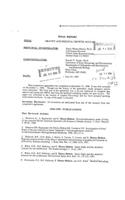
Gravity and Skeletal Growth
Series:
Two simultaneous experiments were performed using 5-week-old male Sprague Dawley rats; in one study, the rats were flown in low earth orbit; in the other study, the hindlimbs of the growing rats were elevated to prevent weight bearing. Following 9 d of unloading, weight bearing was restored for 4, 28, and 76 hrs. Afterwards, additional hindlimb unloading experiments were performed to evaluate the
NaN
VOLUME
English
Paperback

Two simultaneous experiments were performed using 5-week-old male Sprague Dawley rats; in one study, the rats were flown in low earth orbit; in the other study, the hindlimbs of the growing rats were elevated to prevent weight bearing. Following 9 d of unloading, weight bearing was restored for 4, 28, and 76 hrs. Afterwards, additional hindlimb unloading experiments were performed to evaluate the skeletal response to 0, 2, 4, 6, 8, 10, 12, 16, and 24 hrs of restored weight bearing following 7 d of unloading. Cancellous and cortical bone histomorphometry were evaluated in the left tibia at the proximal metaphysis and in the left femur at mid-diaphysis, respectively. Steady-state mRNA levels for bone matrix proteins and skeletal signaling peptides were determined in total cellular RNA extracted from trabeculae from the right proximal tibiametaphysis and periosteum from the right femur. Spaceflight and hindlimb unloading each resulted in cancellous osteopenia, as well as a tendency towards decreased periosteal bone formation. Both models for skeletal unloading resulted in site specific reductions in mRNA levels for transforming growth factor-beta (sub 1) (TGF-beta) osteocalcin (OC), and prepro-alpha (I) subunit of type 1 collagen (collagen) and little or no changes in mRNA levels for glyceraldehyde-3-phosphate dehydrogenase (GAP) and insulin-like growth factor I (IGF-I). Restoration of normal weight bearing resulted in transient increases in mRNA levels for the bone matrix proteins and TGF-beta in the proximal metaphysis and periosteum and no changes in either GAP or IGF-I mRNA levels. The timecourse for the response differed between the two skeletal compartments; the tibial metaphysis responded much more quickly to reloading. These results suggest that the skeletal adaptation to acute physiological changes in mechanical usage are mediated, in part, by changes in mRNA levels for bone matrix proteins and TGF-beta.Morey-Holton, Emily and Turner, Russell T.Ames Research C...
Price Comparison [India]
In This Series
Bestseller Manga
Trending NEWS




















